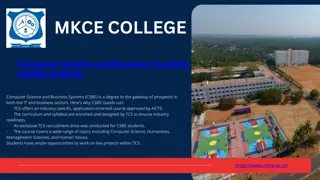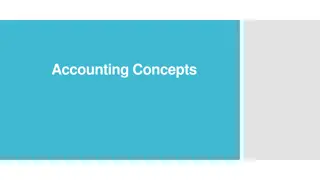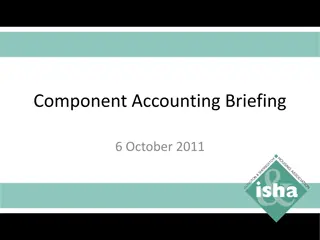Introduction to Computer-Based Accounting Systems in Business
Information systems play a crucial role in modern business operations, particularly in accounting. This course covers topics such as setting up accounts, using software like Sage, and analyzing financial data. Computer-based accounting offers advantages such as accuracy and speed, but also comes with challenges like initial costs and potential errors. Students will learn how to utilize accounting software effectively and understand the impact of information systems on accounting processes and decision-making.
Download Presentation

Please find below an Image/Link to download the presentation.
The content on the website is provided AS IS for your information and personal use only. It may not be sold, licensed, or shared on other websites without obtaining consent from the author. Download presentation by click this link. If you encounter any issues during the download, it is possible that the publisher has removed the file from their server.
E N D
Presentation Transcript
Accounting Information Systems with ERP Applications ICT 30430
Assessment Methods Class Tests (10 marks x 4 tests) Final Examination Total Marks 40 60 100 Class Tests Will be held during the lecturers. If a student absent for the test, no marks allocated. There will be 4 tests during the semester.
Course Outline Introduction to Information Systems Introduction to Sage 50 Accounting Creating a Company Setting up General Ledger Entering Budgets, Beginning Balances and Prior Period Adjustments
Course Outline Setting up Accounts Payables Setting up Inventory Setting up Customers Using Accounts Payable (Suppliers) Using Inventory (Stocks) Using Account Receivable (Customers)
Course Outline Customer Receipts & Other Income Receipts Vendor Payments and Other Payments Using General Journal and Banking Tasks Accessing Reports/Forms and Running the Year-End
What is Computer Based Accounting? Carrying out functions in the accounting process using a computer software. There are three ways of computer based accounting. Using a spread sheet package (e.g. Ms Excel) Using a Accounting Software Package (e.g. Sage) Using an Enterprise Resource Planning System ERP (e.g. SAP)
What is Computer Based Accounting? Advantages Accuracy Speed Storage capacity Cost reduction Up-to-date reports Analyzing capabilities Disadvantages Initial cost Replacement requirements Human errors System errors
Introduction to information systems Information systems have become an important part of today's society, particularly in business The term information system (IS) sometimes refers to a system of persons, data records, and activities that process the data and information in an organization As an accountant, you are affected by developments in information technology Information systems collect business data that accountants analyze, and business plans and decisions are made based on such analyses
Introduction to information systems Accountants are concerned not only with the collection and processing of information, but also with its integrity and protection They are often expected to give professional feedback on the adequacy of the information systems. It is therefore essential for you to have adequate knowledge in information systems and technology.
What is an information system? An information system is a specialized type of system designed to collect data and turn them into information. It consists of interrelated components that perform the following four major activities in sequence: 1. input 2. processing 3. output 4. feedback
Major types of information systems E-business One of the fastest growing sectors is electronic business or e-business. These applications make use of websites and the Internet to facilitate business transactions Transaction processing systems These systems were designed to facilitate day- to-day operations of businesses, such as payroll, sales, accounts payable, inventory, and accounting
Major types of information systems Management information systems and decision support systems Typically, these systems produce information for middle management in the form of scheduled reports such as summaries and lists Special-purpose information systems assist senior management to make more effective decisions of a complex nature, in new situations, or for speculation
Justifying computer-based information systems Business use of information systems has evolved through a series of three stages: cost reduction and productivity (1960s) competitive advantage orientation (1980s) performance-based (current)
What is ERP System ERP, or enterprise resource planning, is an integrated system that allows a company to fully manage the manufacturing process to be able to hold on to less inventory and obtain more data to better manage the situation. ERP provides an integrated view of core business processes, often in real-time, using common databases maintained by a database management system
Accounting software Vs ERP Accounting software ERP
SAP ERP- INTERFACES (cont d)
SAP ERP- INTERFACES (cont d)
SAP ERP- INTERFACES (cont d)
Accounting Software Packages General (Tailor-made) MYOB Account Pro Peachtree/Sage 50 DacEasy ACCPAC SAGE Tally Quick Book Special (Customized) Stock control systems Payroll systems General ledger systems Debtors/Creditors modules Cash books
Accounting Software Packages Accounting software packages can be supplied in Individual (stand alone) or Total Integrated Package In a stand alone system, modules are purchases separately, the transfer of values to the GL or to other modules Printing control total and posting them Creating transfer file for posting In an integrated system , all modules are supplied together and operated together Information created in one module automatically flows to other modules
Accounting Software Packages An accounting package organizes an accounting database comprising a number of files to provide accounting information required by the users. These files are fallen into three categories: Master files Transaction files Temporary/ working files
Master Files Master files contain relatively static data plus some quantitative values which are periodically updated by entry of transactions Debtors master file Creditors master file General ledger master file Stock master file Fixed asset register Payroll master file
Transaction Files Transaction files summarize data available in source documents, Purchase/ Sales Orders Invoices Return Notes Receipts Normally used to update balances in the master files
Temporary/ Working Files Temporary files are short term files, kept for specific purposes, data in which will be deleted when the purpose has been fulfilled. Suspense Account Waiting on Bill Advances Received
Sage 50 Provides advanced analysis tools and 140+ customizable reports and financial statements It is ideal for people who want accuracy and control, so they can achieve better business results. It can be installed to the Single/Stand-Alone Computer or a Network
Sage 50 There are several ways to open Sage 50 From the Taskbar Select Start Select Program Select Sage 50 Accounting 2013 - Click Sage 50 Accounting 2013 icon From the Desktop Double-click Sage 50 Accounting 2013 icon
The Sage 50 Desktop Window Title Bar Menu Bar Button Control Bar Navigation Centers Short Cuts Business Status Center Navigation Bar























